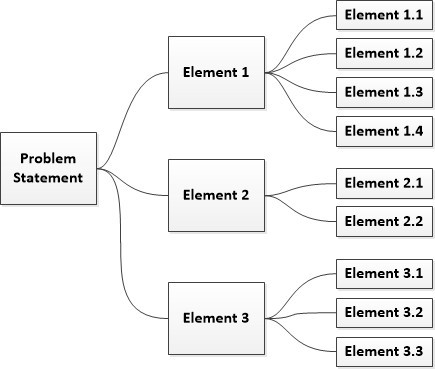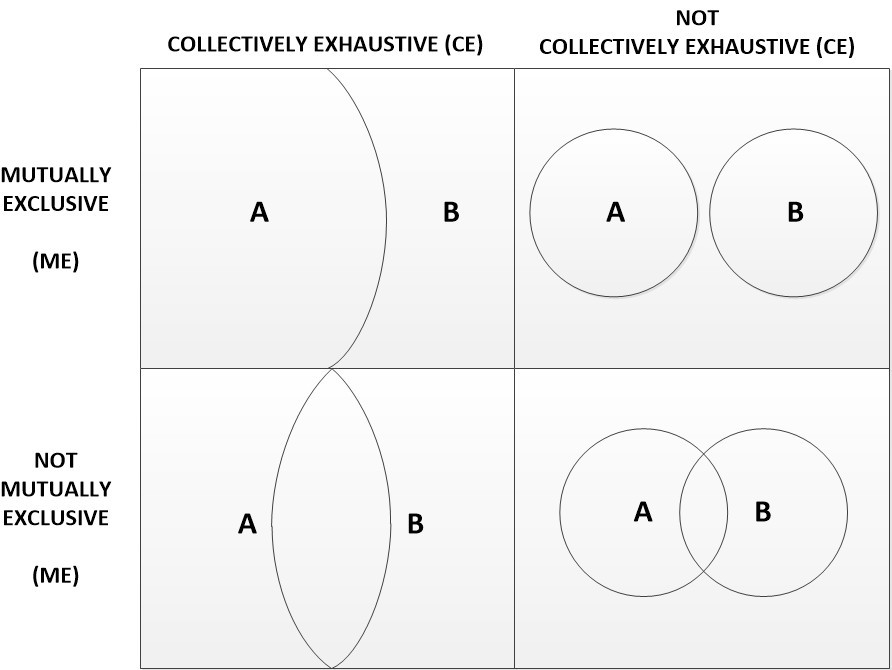Problems can sometimes be exceedingly messy, things can get painfully complicated, and communication across stakeholders can seem almost impossible. Logic tree diagrams can be a practical, invaluable, and deceivingly easy tool to help in these situations!
This post explores what logic tree diagrams are, the various types of diagrams, and where they can be useful in strategy and project management.
Basics of Logic Tree Diagrams
 Logic tree diagrams are a useful problem solving tool. They enable you to break down problems – disaggregate them – into digestible pieces that can be solved.
Logic tree diagrams are a useful problem solving tool. They enable you to break down problems – disaggregate them – into digestible pieces that can be solved.
The diagram at right illustrates a completely generic logic tree diagram. It is easy to take your problem and construct one of these – on paper, on a white board, or on your computer.
One key is to develop a clear problem statement. The diagram enables you to record what your initial statement, begin thinking it through, and even go back and revise your problem statement.
Once you have done a rough cut logic tree diagram, you will have a visual representation of the whole problem. You will be able to visualize the problem and see relationships among the constituent parts.
In short, a good logic tree diagram will help provide you with a visualization of the key factors effecting your problem, the major components of the problem, and the influential levers that you may be able to effect.
Types of Logic Tree Diagrams
The following are some basic types of logic tree diagrams:
- Factor / Lever/ Component – These diagrams are helpful in beginning to understand a problem, when limited knowledge and information is available. The first level elements are factors, levels, or components of the problem. The second level elements are some further breakdown that helps disaggregate and understand the first level elements.
- Inductive Logic Tree – This type of tree is actually the reverse of all the others. Since inductive reasoning is deriving meaning from actual observations, the tree starts with sub-elements (observations) on the left, moving to more generality on the right, and finally the problem or thesis statement to the far right.
- Deductive Logic Tree – Deduction is the exact opposite of induction. With a very clear idea of the structure of the problem, the problem statement is on the left, the first level elements describe a component relationship to the problem, and the second level develops factors contributing to the relationships.
- Hypothesis Tree – This is used when you know enough about your problem structure to begin to hypothesize about solutions. The first level elements are the hypotheses about possible solutions or conclusions about the problems. The second level elements are various facts and assertions to use in testing the hypotheses.
- Decision Tree – When a great deal is known, the Decision Tree can be used to clearly lay out the information logically. The tree would include an if-then structure where you could explore potential outcomes of each decision. It’s not just one decision, but a series of decisions.
These are some broad, basic types of logic trees. In actual practice, the use of logic trees can be tailored to the nature of whatever problem you are trying to solve.
Mutually Exclusive, Collectively Exhaustive (MECE)
 The concept of Mutually Exclusive and Collectively Exhaustive (MECE) is a very important concept for constructing useful logic trees. Here’s what it means:
The concept of Mutually Exclusive and Collectively Exhaustive (MECE) is a very important concept for constructing useful logic trees. Here’s what it means:
- Mutually Exclusive (ME) – This means that each element represented in the tree is completely unique. There is no overlap or repetition among any of the elements in the tree. If you find that the tree you are constructing does have some overlapping elements, work to redefine them to make them mutually exclusive.
- Collectively Exhaustive (CE) – This means that the whole universe of worthy considerations around the problem are included. If you leave something out, you may miss an important consideration or part of the problem, which may lead you to a sub par solution. Brainstorming with all stakeholders is a great way to ensure that everything important is considered.
Note that in the process of brainstorming to create a logic tree, you will come up with some elements that have minimal impact. While MECE guides you to be thorough, it is fair game to eliminate elements that have minimal impact.
Using Logic Tree Diagrams in Strategy
Here are three ways you can use Logic Tree Diagrams as an analysis tool in formulating strategy:
- Established for profit businesses – In business, organizations can use deductive logic trees to help make decisions. In particular, they can perform financial analyses and even compare different companies on financial benchmarks to ascertain competitive positions and options. This can help point to strategic adjustments that should be made.
- Government or not-for-profit sector – Challenges can be ‘messy’, and logic trees can help make them more understandable. Logic trees, by virtue of disaggregating the problem space, can be used to scope projects properly, gain an overall understanding of the problem space, identify possible solutions, work through the merits of each, and provide a great communication tool to gain input across the stakeholder community.
- Startups – Logic diagrams can provide clarity on direction and unanswered questions. They can point to areas of effort that are most important for clarifying the direction ahead. They can also point to the need to change direction when necessary. Logic diagrams can provide startups with a useful navigation tool that works very well where agility is needed.
These are just general uses. The real power comes by actually applying logic trees to actual situations to solve problems and seize opportunities.
Using Logic Tree Diagrams in Project Management
—————————————-
I recommend these PM templates (paid link):
—————————————-
The following are three ways you can use Logic Tree Diagrams in the practice of project management:
- Solving problems – Often times requirements are not clear, or solutions are not easy. Logic tree diagrams can help to sort out such common project issues. I have found logic tree diagrams to most useful in pointing to solutions when there is actually no perfect option. The diagram illustrates how there is no perfect solution, signaling a solution that at least leads you to cope with the problem.
- Making decisions – A decision tree is a great tool to help a team to think through the options and weigh the merits of the options. They ensure that the problem is considered in its totality. They also provide a structure to logically think through alternatives. They also show visually the relationships among alternatives and can help at least narrow down the options.
- Presenting alternatives to stakeholders – Solving problems and making decisions is a group activity. While sometimes logic trees are good tools to use on your own, most of the time the problems will be bigger and require input from many people. Whether presenting to a group, or sketching out alternatives, logic tree diagrams are a great tool for getting all heads around the problem, getting everyone’s ideas on solutions, and selling the best solution.
These are only a few general ways that logic trees can be used as an effective tool in managing projects.
Logic Tree Diagrams for General Problem Solving
I hope this post has opened your eyes to the value and practicality of logic tree diagrams at solving problems. Has it triggered any ideas for use on a problem you are facing right now, or have you already used logic tree diagrams to solve an interesting problem?
—————————————-
I recommend these strategy resources (paid link):
—————————————-

